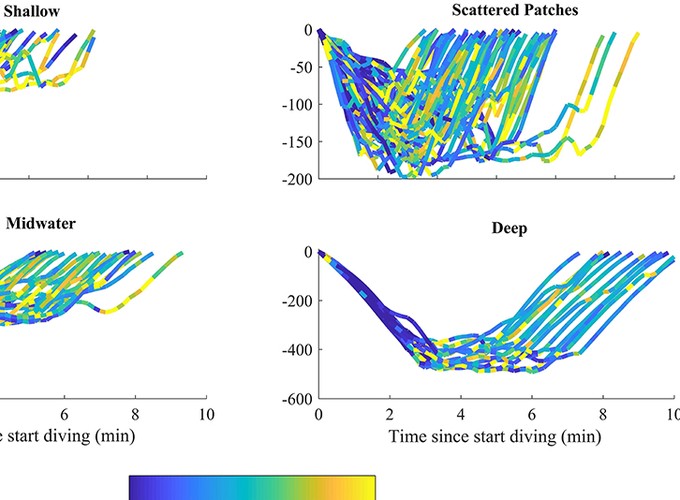Diving behavior and fine-scale kinematics of free-ranging Risso's dolphins foraging in shallow and deep-water habitats

Diving behavior and fine-scale kinematics of free-ranging Risso's dolphins foraging in shallow and deep-water habitats
Abstract
Air-breathing marine predators must balance the conflicting demands of oxygen conservation during breath-hold and the cost of diving and locomotion to capture prey. However, it remains poorly understood how predators modulate foraging performance when feeding at different depths and in response to changes in prey distribution and type. Here, we used high-resolution multi-sensor tags attached to Risso’s dolphins (Grampus griseus) and concurrent prey surveys to quantify their foraging performance over a range of depths and prey types. Dolphins (N = 33) foraged in shallow and deep habitats [seabed depths less or more than 560 m, respectively] and within the deep habitat, in vertically stratified prey features occurring at several aggregation levels. Generalized linear mixed-effects models indicated that dive kinematics were driven by foraging depth rather than habitat. Bottom-phase duration and number of buzzes (attempts to capture prey) per dive increased with depth. In deep dives, dolphins were gliding for >50% of descent and adopted higher pitch angles both during descent and ascents, which was likely to reduce energetic cost of longer transits. This lower cost of transit was counteracted by the record of highest vertical swim speeds, rolling maneuvers and stroke rates at depth, together with a 4-fold increase in the inter-buzz interval (IBI), suggesting higher costs of pursuing, and handling prey compared to shallow-water feeding. In spite of the increased capture effort at depth, dolphins managed to keep their estimated overall metabolic rate comparable across dive types. This indicates that adjustments in swimming modes may enable energy balance in deeper dives. If we think of the surface as a central place where divers return to breathe, our data match predictions that central place foragers should increase the number and likely quality of prey items at greater distances. These dolphins forage efficiently from near-shore benthic communities to depth-stratified scattering layers, enabling them to maximize their fitness.